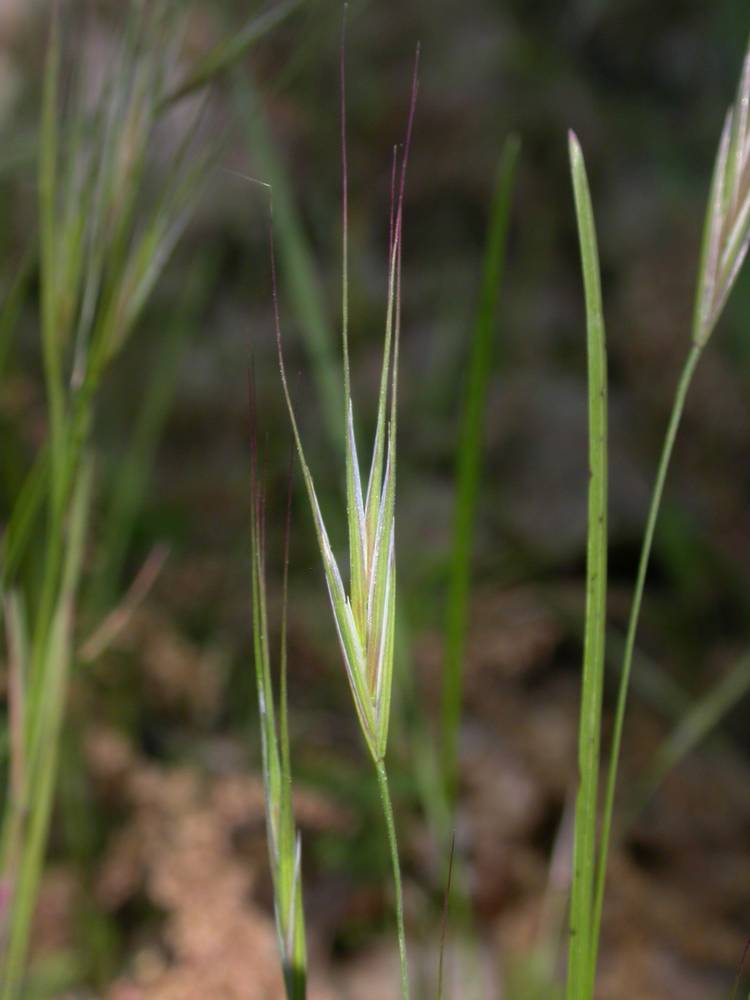
Plants annual, 35–100 cm tall.
Culms glabrous.
Leaves sheaths densely pubescent; blades 4–20 cm × 1–6 mm, hairy on both surfaces.
Inflorescences 10–20 × 5–12 cm, open, nodding; branches spreading, usually longer than the spikelets; with 1–2 spikelets.
Spikelets 20– 35 mm, moderately laterally compressed, with 5–9 florets.
Glumes smooth or scabrous; lower glumes 8–10 mm, 1(3)-veined; upper glumes 12–15 mm, 3(5)-veined.
Lemmas 14–20 mm, narrowly lanceolate, pubescent or puberulent, 7(9)-veined; margins hyaline; tips acuminate, bifid, with teeth 0.2–3 mm, awned; lemma awns 15–30 mm, straight.
Anthers 1–1.4 mm.
2n=42, 56.
Dry disturbed areas, overgrazed rangeland, disturbed grasslands. 0–1700m. Casc, Col, CR, Sisk, WV. CA, ID, NV, WA; north to British Columbia, east to CO and TX, eastern North America; Europe. Exotic.
This weedy brome with its long, dangling awns is very similar to B. diandrus except that it is more delicate with its smaller glumes, lemmas, and awns.
as described under Bromus sterilis
style="mso-bidi-font-weight: normal">Plants annual. Culms 35-100 cm, erect or geniculate near the base, glabrous. style="mso-bidi-font-weight: normal">Sheaths densely pubescent; auricles absent; ligules 2-2.5 mm, glabrous, acute, lacerate; blades 4-20 cm long, 1-6 mm wide, pubescent on both surfaces. style="mso-bidi-font-weight: normal">Panicles 10-20 cm long, 5-12 cm wide, open; style="mso-bidi-font-weight: normal">branches 2-10 cm, spreading, ascending or drooping, rarely with more than 3 spikelets. Spikelets 20-35 mm, usually shorter than the panicle branches, sides parallel or diverging distally, moderately laterally compressed, with 5-9 florets. Glumes smooth or scabrous, margins hyaline; lower glumes 6-14 mm, 1(3)-veined; upper glumes 10-20 mm, 3(5)-veined; lemmas 14-20 mm, narrowly lanceolate, pubescent or puberulent, 7(9)-veined, rounded over the midvein, margins hyaline, apices acuminate, bifid, teeth 1-3 mm; awns 15-30 mm, straight, arising 1.5 mm or more below the lemma apices; anthers 1-1.4 mm. 2n = 14, 28.
style="mso-bidi-font-style: normal">Bromus sterilis is native to Europe, growing from Sweden southward. It now grows in North America in road verges, fields, waste places, and overgrazed rangeland. It is widespread in western and eastern North America, but is mostly absent from the Great Plains and the southeastern states.